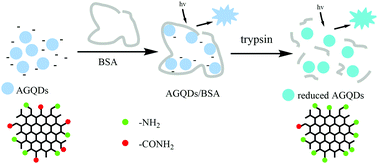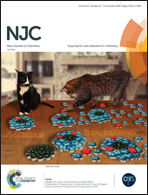Construction and comparison of BSA-stabilized functionalized GQD composite fluorescent probes for selective trypsin detection†
Abstract
Herein, three kinds of functionalized fluorescent graphene quantum dots (GQDs), as molecule-like building blocks, were used to prepare bovine serum albumin (BSA)-stabilized composite probes. The properties of three types of GQDs and their corresponding BSA-stabilized GQD composite probes were compared using various characterization methods, including FT-IR, TEM, zeta potential measurements, and fluorescence spectroscopy. These three types of BSA-stabilized functionalized GQD composite fluorescent probes were applied to selective trypsin detection. The optimized conditions for preparing composite nanoprobes and optimal detection circumstances were further investigated. Different BSA-stabilized GQD composite probes were used as novel selective label-free fluorescent biosensors for trypsin, proving to have a marked fluorescence enhancement effect, high selectivity, and sensitivity. The most suitable composite probe of the three was selected. The BSA-stabilized amino-functionalized GQDs were the best trypsin sensors among the three tested, with a lower limit of detection of 0.004 μg mL−1. The selective detection mechanism for trypsin was also further studied. This represents the first use of BSA-stabilized GQDs as selective trypsin sensors. Differently functionalized GQD composite probes for trypsin detection were compared and discussed to investigate the selective detection mechanism.



 Please wait while we load your content...
Please wait while we load your content...